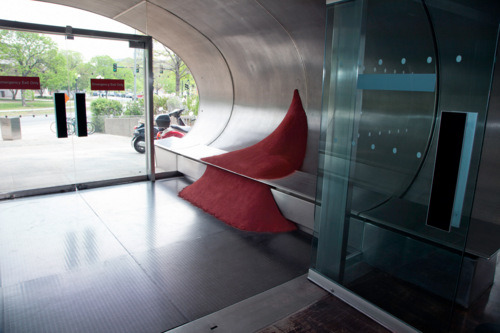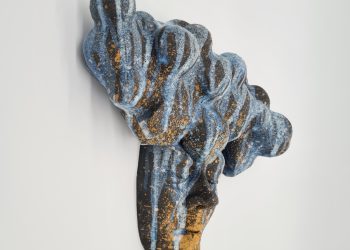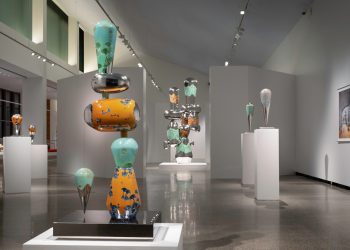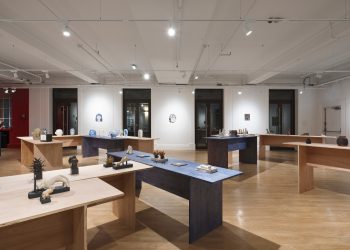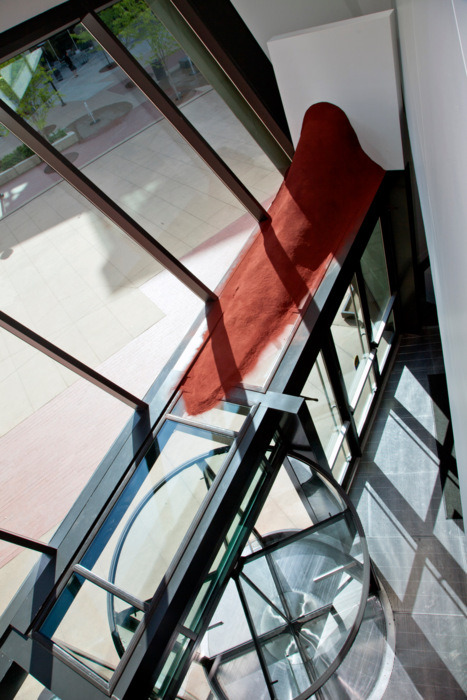
Collecting the edges is the name of your work exhibited at the Overthrown: Clay Without Limits exhibition. It’s a site-specific project that enhances the corners and the ceiling of the space, but it also enhances the edges of the exhibition. Tell us about this project.
Collecting the edges is a response to the architecture of the two buildings one designed by Ponte and the other by Libeskind. The work I made collects and focuses their shared dialogues of space and light across the whole museum site. When moving thought the two buildings you become aware of the complexity of the architecture of both guiding you through the depth and layers of the buildings, my work responds to this. The soft, rich clay dust has collected in the edges of these architectural details and staggering flights of space in both buildings. The clay acts as one authorship uniting the two buildings for the time of this exhibition.
The pure red Colorado clay drifts describe the material alone, the way they ease up against the architecture describe the shapes and light in the building.
The temporary nature of this work allows it to be at a different pace to the monumental structures it is formed by. It is a reminder of a moment in time, rather than a permanent demand.
From all the artists exhibiting at the Overthrown, you seem to have an outstanding easiness of making site-specific installations. Where did you learn this?
When I left the RCA 15 years ago, installation work in the field of the applied arts was in its infancy. This allowed me to create my own language of large scale and temporary works that did not become a competitive language but a meaningful exploration of potential within a material specific dialogue.
Through critical appraisal and practical learning in visual languages and context, the work I have made has developed and is nurtured by all the wonderful curators I have had the opportunity to work with. In all the projects I have worked on the curators and myself have only hoped to make new work that can question the current contexts of making and meaning within the structures of craft, clay and the wider visual arts. Part of this is my personal drive to make work that continues to challenge the work I have made and that I want to make the future. To learn this is only to look at a set of skills, to want to be immersed in this, is a personal undertaking that involves the kind of risk that is outside of a given learning environment.
Your previous works have been exhibited at Tate and Victoria and Albert Museum; how did you receive Gwen Chanzit’s invitation of exhibiting your works at the Denver Art Museum? Tell us how long it took to come up with the project.
Then I was installing my work “a dark day in Paradise” 2010 at the Brighton Pavilion I received a phone call from Gwen Chanzit. I remember this clearly as I was sitting in a chair looking at a stuffed duck on a platter in the grand kitchen whilst also directing the composition of hundreds of black ceramic batteries from the ceiling in the great kitchen.
Gwen talked with great passion and intelligence of the museum’s intention to focus on clay across the whole museum for the duration of summer 2011. This was an amazing idea that a whole museum and its collection would lay emphasis on one material. I was immediately taken with the ambition of this and Gwen’s invitation to make a new work across the whole museums architecture was second to none. This felt like it would be a defining moment to examine scale, architecture and languages across a broad site.
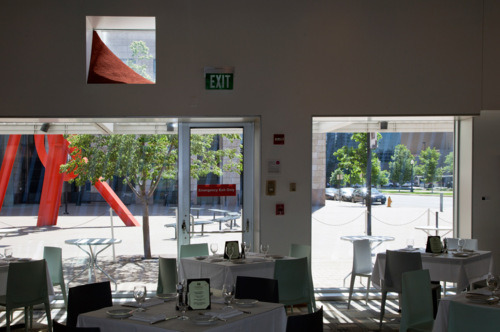
Clare Twomey, Collecting the edges. 2011. Red clay dust. Site-specific project for the Denver Art Museum supported by Jana and Fred Bartlit. Photo by Jeff Wells
My work would sit across the whole museum and also reach into the contemporary clay exhibition – Clay without limits. The artists invited to this exhibition were all my contemporaries, they are the defining makers of our time, I was thrilled to have a shared dialogue in this context. It was a privilege to be invited to make a vast work and be in the context of such a groundbreaking and enabling exhibition.
From London to Denver we shared books, pictures and architectural plans, Gwen visited my studio in London, and I made a site visit to the Museum. When visiting a site one must arrive with a very open mind, I had on our first visit no planned ideas for the work. I made a response to the architecture I experienced, and this was vastly influential in the development of the concept.
The whole development happened in one year from the invitation through to delivery in the museum. The museum was incredibly supportive of a challenging work.
What do you think about the exhibition, about its scale? Overall, there are 25 exhibiting artists.
The exhibition Clay without limits is a moment in time; the lead thinkers and makers of clay work in the USA and beyond responded with ambition to Gwen’s invitation. The nature of Gwen’s invitation is the core of the curatorial prowess of the exhibition. She approach the artists and gave them an opportunity to make works for the future, each artist I feel had not done what they did before, Gwen’s good curatorial sensibilities drew out the best work these makers have produced to date. It is a great exhibition.
The groups of artists that are bound together in this exhibition possibly for the first time, here they are seen as a movement. We can see in the landscape of making how these artists make sense as a group, a large group. We can see what happens at the centre what happens on the edges. If this show had been any smaller, it might have replicated exhibitions that came before but its scale means that now we can see clearly where we are now and what the future holds.
What are you working on now?
I am currently the artist residence at the Victoria &Albert Museum in London. This is a 6-month residence that is in a studio in the middle of the ceramics collection. The residency acts as live studio in the museum; I am working experimental works looking authenticity and multiples. The web pages that link to this are http://www.vam.ac.uk/content/people-pages/clare-twomey/
As research Fellow at the University of Westminster, I have just started work on a 3-year project that investigates the history and impact of ceramic installation in museums. Within this project given funding from the AHRC, myself and my fellow investigators, Christie Brown and Edmund de Waal will be publishing works, a website and a collection of texts.
The next fully formed work that will be on exhibit is that for an Art Museum in Bergen, Permanenten The West Norway Museum of Decorative Art. For the exhibition Thing Tang Trash-Up cycling in Contemporary Ceramics. This work is a vast work that spreads from the grand entrance to the main exhibition gallery.
First photo: Clare Twomey, Collecting the edges. 2011. Red clay dust. Site-specific project for the Denver Art Museum supported by Jana and Fred Bartlit. Photo by Jeff Wells.
Born in 1968, UK, Clare Twomey lives and works in London, UK.
Clare Twomey is a British artist and a research fellow at the University of Westminster who works with clay in large-scale installations, Sculpture and site-specific works. Over the past 10 years she has exhibited at the Victoria and Albert Museum, Tate, Crafts Council, Museum of Modern Art Kyoto Japan, the Eden Project and the Royal Academy of Arts.
Within these works Twomey has maintained her concerns with materials, craft practice and historic and social context.
Clare Twomey’s installations have the social and historical context in which the installation is created as their point of departure. Often they only exist within these frameworks. A number of her installations disappear or perish in the course of the exhibition period as part of the work. Often the onlooker’s mode of behaviour is conceptually included in Twomey’s works. This, for example, applied to the artwork Conscience/Consciousness (2003), in which Twomey had covered the floor of the gallery with very thin ceramic tiles which broke when trodden on.
At the Brighton Pavilion she housed thousands of black butterflies that became a veil of mourning in amongst the wonderful yet menacing rooms of the Pavilion creating a discussion about the indulgence and excess of the building and its creation.
At the Royal Academy she worked with the traditional flower makers in stoke on Trent to make hundreds of exotic flowers in a work titled Specimen that examined the protection of objects and the destruction of objects as the flowers were not fired and exposed to the publics touch through the exhibition. This vulnerability relates top the losing of craft skills in Stoke on Trent.
Clare Twomey is actively involved in critical research in the area of the applied arts, including writing, curating and making. She has developed work, which expands the fields’ knowledge of larger scale installation works.
By Vasi Hirdo
Published in Ceramics Now Magazine Issue 1.
Visit Clare Twomey’s website.


